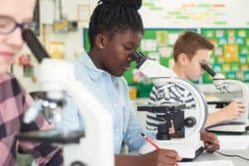Phenomenon-Based Learning and the 5-E Model: A Phenomenal Pair!
If you have read any of my posts, you know I am passionate about finding ways to stir up student interest and get them curious about the world around them. Once that spark is alive, students become motivated to learn. That’s why I see phenomenon-based learning (PhBL) as an important tool for the science teacher’s toolbox, especially for upper elementary and middle school students. Basing a lesson plan around cool science is not new. But building a 5E instructional framework around a compelling phenomenon moves all of it to a new level. It is such a great match that it deserves to be spelled out. I’d like to tell you what PhBL is and how the 5E model of inquiry-based learning works with it.
What Exactly is Considered a "Phenomena"?
Phenomenon-based learning begins with real-world experience or observation. Merriam-Webster defines phenomena as “an observable fact or event…of scientific interest susceptible to scientific description and explanation.” Direct exposure to phenomena engages students’ natural curiosity about their environment. Let’s say your students were interested in Forensics information and skills. You could present the lesson in a crime scene format to get their interest. Curiosity is a gateway to students developing their own ideas when they explore and apply them to the situation. Math and ELA fit easily within this inquiry experience, as they read lab reports, data, graphs, and charts or write opinion essays about ethics and justice. Mixing disciplines within a topic encourages students to learn across the curriculum. The core phenomenon drives the study, both for deep learning and for connecting with multiple ways the same phenomenon touches different aspects of the world. We can contrast that with traditional, subject-based (silo) learning settings, where teachers use examples to illustrate concepts or theories to students.
What Are the Essential Parts of a Good PhBL?
The phenomenon itself is not the whole picture, nor is it fully explained by just observing it. In middle school and upper elementary grades, the best phenomena to investigate happen within a familiar context, such as, “Why do people say eating too much candy makes kids hyper?”, making it accessible to all students. Familiarity and accessibility with the phenomena (i.e., I can see this around me or easily try this in a lab) also create equity for most students, regardless of school setting or resources. To continue the crime scene example, students can consider genetics, compare types of crime in an area, and look at how details of evidence tell information about the situation. Students recognize a phenomenon as part of their world, and their teachers can naturally pair relevant phenomena with inquiry-based or project-based study. Then, students find their own answers to “why do I need to learn this?” and they want to learn more about it.
PhBL requires study within larger, real-world contexts because topics cross between the sciences. For example, a physical science phenomenon often involves other sciences like chemistry or ecology. A concept as basic as gravity or a question like “Why do things fall down?” can take your students on a journey. From Newton’s Laws to what is needed for space travel to the moon’s pull on the tides to the human impacts on the oceans. The phenomenon-based learning process makes sense of what the students discover using tools and skills to think and act like scientists or engineers. Doing the investigation helps students solve the why and how of the phenomenon.
The 5E Framework is Well Suited for Studying Phenomena
Consider the 5E model – engage, explore, explain, extend, and evaluate – within the following example:
An essential question (raised with the first exposure to the phenomenon), such as “How does a ship float on water when it is so big and heavy?” engages students and leads them to explore, make predictions and experiment like scientists. Perhaps they will test different types of vessels to find out what shape, weight, or other things they need to consider to build the largest or strongest floating container. Students can then reflect on how their discoveries lead them to make solid connections about (explain) the big question. How well did their conclusions clarify the phenomenon? Students would then be shown or exposed to the phenomenon at a deeper level to reevaluate their positions. Depending on the complexity of the topic and the level of the students, the teacher may choose to give a concrete explanation of the phenomenon. Using the new information, students can extend their understanding by using applied science and engineering in several ways. With many paths to show what they know, evaluation of student progress toward standards should be clear.
Develop Your Own Phenomenon-based Learning Projects
I suggest you begin by choosing a compelling scientific event or fact that easily spans several sciences. Look for video and image examples to intrigue your students. Use a series of labs or activities to guide your students to explore the phenomenon. Well-placed questions and the CER method (claim, evidence, and reasoning) will help students see if they can explain the phenomenon. Next, show or demonstrate the event again, but at a deeper level with an explanation. Then, allow students to return to their studies and extend their understanding. I suggest using a type of concrete extension, where they can apply their ideas by creating in a way other than writing. They could draw or build a model that helps them show their deeper understanding. This step can be part of the evaluation, supporting students who best demonstrate what they learn by doing. The possibilities are endless!
Work Smarter, Not Harder!
Another option is to use a premade lesson like the ones I have created around videos from Steve Spangler. I have wrapped the 5E framework around the amazing phenomena highlighted in his videos. The lessons also include explanation videos made exclusively for Kesler by Steve. (Kesler Science members already have direct access to this outstanding PhBL through the Dashboard!)
Through phenomenon-based learning, you actively engage your students through fascinating natural occurrences and hands-on experiences. This approach often draws in students who are reluctant learners and fosters a sense of discovery and excitement inside your classroom. If you want a new approach to teaching, I hope you will give phenomenon-based learning a try.
Download Over $100 in FREE Resources
For Middle School Science
Simply create a login below and gain immediate access to a selection of our Kesler Science product line worth $100 - for FREE. There's a full version of every product type! You'll also join tens of thousands of middle school science teachers who receive timely tips and strategies straight to their inbox.




